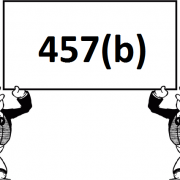 Print Friendly Version
Print Friendly Version
Correcting governmental 457(b) plans
“Does the IRS have a correction program that covers 457(b) plans for governmental employers under the Employee Plans Compliance Resolution System (EPCRS)?”
ERISA consultants at the Retirement Learning Center Resource Desk regularly receive calls from financial advisors on a broad array of technical topics related to IRAs, qualified retirement plans and other types of retirement savings and income plans, including nonqualified plans, stock options, and Social Security and Medicare. We bring Case of the Week to you to highlight the most relevant topics affecting your business. A recent call with a financial advisor from Ohio is representative of a common inquiry related to correcting 457(b) plan errors.
Highlights of the Discussion
Effectively, yes. The two avenues of correction for governmental 457(b) plans are 1) self correction (without a submission); and 2) voluntary compliance (VC) with a formal submission. The IRS accepts VC submissions for governmental plans on a provisional basis under standards that are similar to EPCRS, but that are, technically, outside of the correction system. Qualifying governmental entities are listed in Internal Revenue Code (IRC) § 457(e)(1)(A), and include a
- State;
- Political subdivision of a state (e.g., a county, city, town, township, village or school district); and
- Any agency or instrumentality of a state or political subdivision of a state.
Sponsors of governmental 457(b) plans may self-correct their plans without a formal IRS submission if they did not comply with the Internal Revenue Code (IRC) or regulations in some way. A sponsor has until the first day of the plan year that begins more than 180 days after the IRS notifies it of the failure (IRC Section 457(b)(6) and Treasury Regulation Section 1.457-9(a)). Considering the amount of time governmental entities have to self-correct plan errors, they may not need to make voluntary submissions to the IRS under the following procedures.
The IRS will accept VC submissions for some errors related to 457(b) plans for governmental employers (see Section 4.09 of Revenue Procedure 2016-51 through 2018 and Section 4.09 of Revenue Procedures 2018-52 effective January 1, 2019.) Note, however, the IRS, generally, will not address any issues 1) related to the form of a written 457(b) plan document; nor 2) problems associated with top-hat[1] plans of tax-exempt entities. However, the IRS may consider a submission where, for example, the top hat plan was erroneously established to benefit the entity’s nonhighly compensated employees and the plan has been operated in a manner that is similar to a qualified plan.
The IRS’s VC unit retains complete discretion to accept or
or reject any requests for correction approval. If accepted, VC will issue a special closing agreement.
The steps to voluntary correction are
- Complete IRS Form 8950, Application for Voluntary Correction Program (VCP).
- Compose a cover letter that describes the problem and includes a proposed solution.
- Mail both the form and cover letter to the address listed in the instructions to Form 8950.
Sponsors will receive IRS Letter 5265 acknowledging the submission along with a control number for reference.
Conclusion
The IRS has two avenues of correction for governmental 457(b) plans: self correction without a submission; and voluntary compliance with a submission. Sponsors can refer to IRS Form 8950 and its instructions, along with Revenue Procedure 2016-51 through 2018, and 2018-52 beginning in 2019 for complete details.
[1] Nongovernmental 457(b) “Top Hat” plans must limit participation to groups of highly compensated employees or groups of executives, managers, directors or officers. The plan may not cover rank-and-file employees.









